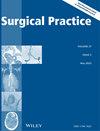Posterior components separation with transversus abdominis release and sublay mesh reinforcement in large ventral hernia repair
Abstract
Aim
Ventral abdominal hernia is a prevalent condition among surgical patients. Large ventral hernias with defects >10 cm that cannot be closed primarily, often with loss of domain requiring abdominal wall reconstruction, pose a surgical challenge. Our study aimed to evaluate the outcomes of posterior components separation (PCS) with transversus abdominis release (TAR) and sublay mesh reinforcement in large ventral hernia repair, particularly in terms of surgical site occurrences (SSOs) and hernia recurrence.
Patients and Methods
Our study included 40 adult patients presented to Tanta University Hospitals with a large ventral hernia (defect width ≥10 cm) from December 2021 to January 2023. All patients were submitted to PCS with TAR and sublay mesh reinforcement.
Results
The mean age of the study population was 47.32 (standard deviation [SD] 9.31) years (range 36–65 years) with a mean body mass index of 33.55 (SD 3.42) kg/m2 (range 28.35–38.72 kg/m2). The major risk factors were obesity (95.00%), smoking (45.00%), and multiparity (45.00%). Midline incisional hernia was the most common type in 28 patients (70.00%). Thirty-four patients (85%) achieved successful midline closure, while six patients required additional anterior components separation technique to achieve tensionless midline closure and an onlay mesh for functional reconstruction. Post-operative SSOs occurred in 12 patients (30.00%), with subcutaneous seroma in 8 patients (20.00%) and wound dehiscence and necrosis in 4 patients (10.00%). Two patients (5.00%) experienced recurrence after a mean follow-up period of 19.25 (SD 3.52) months.
Conclusions
PCS with TAR and sublay mesh reinforcement is a reliable and durable technique for complex ventral hernia repair with low morbidity and recurrence rates. However, long-term clinical outcomes with more cases are required to properly evaluate this technique.

 求助内容:
求助内容: 应助结果提醒方式:
应助结果提醒方式:


